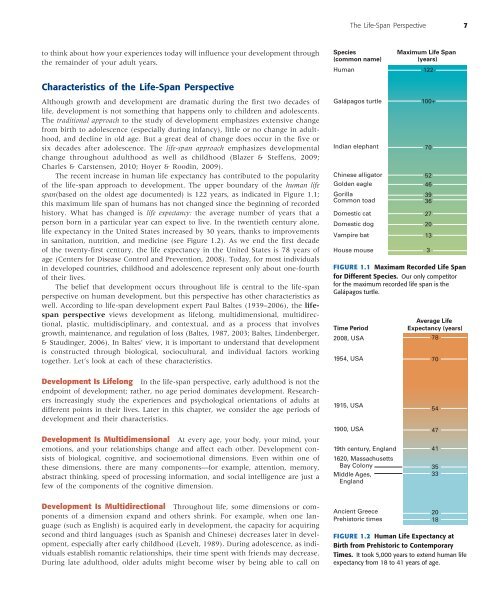Research in Life-Span Development
Research in Life-Span Development
Research in Life-Span Development
Create successful ePaper yourself
Turn your PDF publications into a flip-book with our unique Google optimized e-Paper software.
to th<strong>in</strong>k about how your experiences today will <strong>in</strong>fl uence your development through<br />
the rema<strong>in</strong>der of your adult years.<br />
Characteristics of the <strong>Life</strong>-<strong>Span</strong> Perspective<br />
Although growth and development are dramatic dur<strong>in</strong>g the fi rst two decades of<br />
life, development is not someth<strong>in</strong>g that happens only to children and adolescents.<br />
The traditional approach to the study of development emphasizes extensive change<br />
from birth to adolescence (especially dur<strong>in</strong>g <strong>in</strong>fancy), little or no change <strong>in</strong> adulthood,<br />
and decl<strong>in</strong>e <strong>in</strong> old age. But a great deal of change does occur <strong>in</strong> the fi ve or<br />
six decades after adolescence. The life-span approach emphasizes developmental<br />
change throughout adulthood as well as childhood (Blazer & Steffens, 2009;<br />
Charles & Carstensen, 2010; Hoyer & Rood<strong>in</strong>, 2009).<br />
The recent <strong>in</strong>crease <strong>in</strong> human life expectancy has contributed to the popularity<br />
of the life-span approach to development. The upper boundary of the human life<br />
span (based on the oldest age documented) is 122 years, as <strong>in</strong>dicated <strong>in</strong> Figure 1.1 ;<br />
this maximum life span of humans has not changed s<strong>in</strong>ce the beg<strong>in</strong>n<strong>in</strong>g of recorded<br />
history. What has changed is life expectancy: the average number of years that a<br />
person born <strong>in</strong> a particular year can expect to live. In the twentieth century alone,<br />
life expectancy <strong>in</strong> the United States <strong>in</strong>creased by 30 years, thanks to improvements<br />
<strong>in</strong> sanitation, nutrition, and medic<strong>in</strong>e (see Figure 1.2 ). As we end the fi rst decade<br />
of the twenty-fi rst century, the life expectancy <strong>in</strong> the United States is 78 years of<br />
age (Centers for Disease Control and Prevention, 2008). Today, for most <strong>in</strong>dividuals<br />
<strong>in</strong> developed countries, childhood and adolescence represent only about one-fourth<br />
of their lives.<br />
The belief that development occurs throughout life is central to the life-span<br />
perspective on human development, but this perspective has other characteristics as<br />
well. Accord<strong>in</strong>g to life-span development expert Paul Baltes (1939–2006), the lifespan<br />
perspective views development as lifelong, multidimensional, multidirectional,<br />
plastic, multidiscipl<strong>in</strong>ary, and contextual, and as a process that <strong>in</strong>volves<br />
growth, ma<strong>in</strong>tenance, and regulation of loss (Baltes, 1987, 2003; Baltes, L<strong>in</strong>denberger,<br />
& Staud<strong>in</strong>ger, 2006). In Baltes’ view, it is important to understand that development<br />
is constructed through biological, sociocultural, and <strong>in</strong>dividual factors work<strong>in</strong>g<br />
together. Let’s look at each of these characteristics.<br />
<strong>Development</strong> Is <strong>Life</strong>long In the life-span perspective, early adulthood is not the<br />
endpo<strong>in</strong>t of development; rather, no age period dom<strong>in</strong>ates development. <strong>Research</strong>ers<br />
<strong>in</strong>creas<strong>in</strong>gly study the experiences and ps ychological orientations of adults at<br />
different po<strong>in</strong>ts <strong>in</strong> their lives. Later <strong>in</strong> this chapter, we consider the age periods of<br />
development and their characteristics.<br />
<strong>Development</strong> Is Multidimensional At every age, your body, your m<strong>in</strong>d, your<br />
emotions, and your relationships change and affect each other. <strong>Development</strong> consists<br />
of biological, cognitive, and socioemotional dimensions. Even with<strong>in</strong> one of<br />
these dimensions, there are many components—for example, attention, memory,<br />
abstract th<strong>in</strong>k<strong>in</strong>g, speed of process<strong>in</strong>g <strong>in</strong>formation, and social <strong>in</strong>telligence are just a<br />
few of the components of the cognitive dimension.<br />
<strong>Development</strong> Is Multidirectional Throughout life, some dimensions or components<br />
of a dimension expand and others shr<strong>in</strong>k. For example, when one language<br />
(such as English) is acquired early <strong>in</strong> development, the capacity for acquir<strong>in</strong>g<br />
second and third languages (such as <strong>Span</strong>ish and Ch<strong>in</strong>ese) decreases later <strong>in</strong> development,<br />
especially after early childhood (Levelt, 1989). Dur<strong>in</strong>g adolescence, as <strong>in</strong>dividuals<br />
establish romantic relationships, their time spent with friends may decrease.<br />
Dur<strong>in</strong>g late adulthood, older adults might become wiser by be<strong>in</strong>g able to call on<br />
The <strong>Life</strong>-<strong>Span</strong> Perspective 7<br />
Species<br />
(common name)<br />
Human<br />
Galápagos turtle<br />
Indian elephant<br />
Ch<strong>in</strong>ese alligator<br />
Golden eagle<br />
Gorilla<br />
Common toad<br />
Domestic cat<br />
Domestic dog<br />
Vampire bat<br />
House mouse<br />
Maximum <strong>Life</strong> <strong>Span</strong><br />
(years)<br />
122<br />
100+<br />
70<br />
52<br />
46<br />
39<br />
36<br />
27<br />
20<br />
13<br />
FIGURE 1.1 Maximam Recorded <strong>Life</strong> <strong>Span</strong><br />
for Different Species. Our only competitor<br />
for the maximum recorded life span is the<br />
Galápagos turtle.<br />
Time Period<br />
2008, USA<br />
1954, USA<br />
1915, USA<br />
1900, USA<br />
19th century, England<br />
1620, Massachusetts<br />
Bay Colony<br />
Middle Ages,<br />
England<br />
Ancient Greece<br />
Prehistoric times<br />
3<br />
Average <strong>Life</strong><br />
Expectancy (years)<br />
78<br />
70<br />
54<br />
47<br />
41<br />
35<br />
33<br />
20<br />
18<br />
FIGURE 1.2 Human <strong>Life</strong> Expectancy at<br />
Birth from Prehistoric to Contemporary<br />
Times. It took 5,000 years to extend human life<br />
expectancy from 18 to 41 years of age.

















